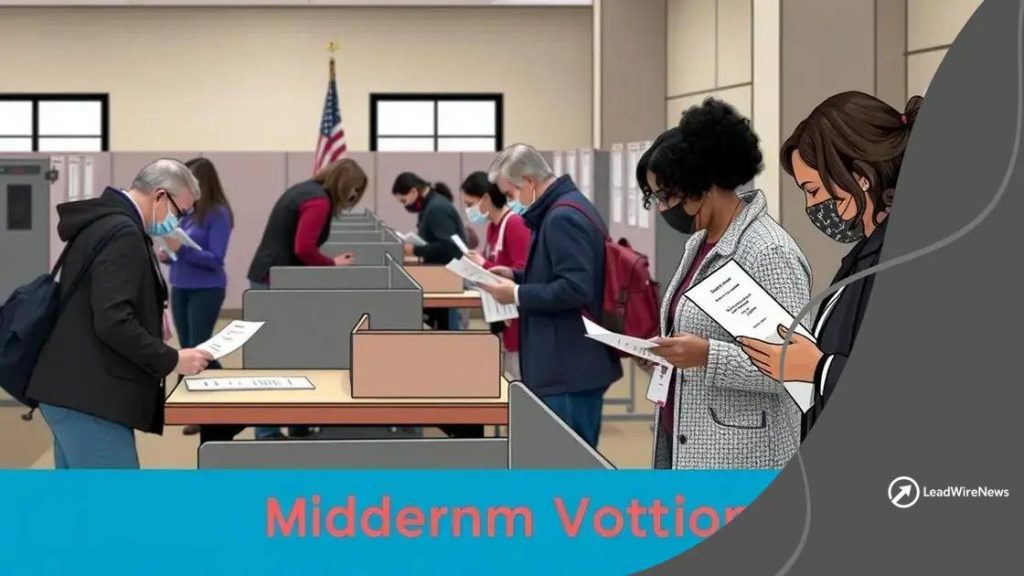Predictions for the 2026 midterm elections: what to expect

Anúncios
Predictions for the 2026 midterm elections indicate that factors like voter turnout, key local issues, social media engagement, and regional trends will significantly influence the outcomes.
Predictions for the 2026 midterm elections are bubbling with excitement as political analysts try to gauge what lies ahead. With candidates positioning themselves and voters’ sentiments shifting, it’s a fascinating time to dive into the numbers and speculate on the potential outcomes. Are you curious about how these elections might unfold?
Anúncios
Key factors influencing the 2026 midterm elections
Understanding the key factors influencing the 2026 midterm elections is crucial for predicting potential outcomes. Many elements come into play, which can shift the political landscape dramatically.
Political Climate and Voter Sentiment
The current political climate shapes how voters feel about candidates and issues. As we approach 2026, both local and national events will play a role. For instance, economic reports may sway opinions. If people feel secure, they may favor the incumbent party. However, if issues arise, they could lean the other way.
The Role of Key Issues
Specific issues often dominate election cycles, and 2026 will be no exception. Voters may prioritize:
Anúncios
- Healthcare and access to services
- Economic stability and job creation
- Climate change and environmental policies
- Social justice and equality movements
These topics resonate with many communities. As parties position their platforms, these issues will become focal points for debate.
Impact of Social Media
Social media will continue to be a powerful tool in shaping voter opinions. Candidates will leverage platforms to connect with their audience directly. The effectiveness of these strategies can mobilize younger voters, a demographic that heavily engages online. Therefore, monitoring these interactions will provide insights into shifting voter trends.
Another important aspect is how misinformation can spread on social channels, potentially influencing perceptions about candidates or policies. Understanding this dynamic will be essential.
As we analyze these factors, we realize the 2026 midterm elections may be influenced by a combination of traditional campaigning and modern digital strategies. Engaging with voters personally, addressing their concerns, and being visible in online spaces will set candidates apart.
Potential candidates to watch in 2026
As the 2026 midterm elections approach, identifying potential candidates to watch is essential for understanding the political landscape. Many individuals are likely to rise to prominence, influencing the direction of the elections.
Incumbent Candidates
Incumbents often have the advantage of name recognition and established support. Voters tend to gravitate toward familiar faces. Observing the actions of current representatives as they prepare for reelection can give insight into their strategies and challenges.
Emerging Leaders
Newcomers can shake up the traditional political arena. Many young, energetic leaders are stepping forward, aiming to connect with the younger electorate. These candidates may focus on:
- Social justice initiatives
- Climate action policies
- Educational reforms
- Economic opportunities for all
Their platforms often resonate with voters seeking change and improvement.
Diverse Representation
As political parties push for diversity, candidates representing various backgrounds and experiences are emerging. This trend is crucial in capturing the essence of a changing electorate. Joining the race are individuals who can speak to the needs of underrepresented communities, aiming to ensure that everyone has a voice in Washington.
Additionally, candidates who actively engage in community issues can set themselves apart. By addressing local concerns, they connect with voters on a personal level.
As candidates campaign, their ability to adapt and address the public’s concerns will play a significant role in their success. Whether they are seasoned politicians or fresh faces, each candidate has the potential to shape the midterm elections in 2026.
How social media may impact voter turnout

The influence of social media on voter turnout is becoming more significant in today’s elections. Various platforms provide a space for candidates to connect with voters and share their messages directly.
Engagement Through Direct Connection
Social media allows candidates to engage with their audience in real-time. This interaction fosters a sense of community and can lead to increased interest in the elections. Candidates can share updates, live videos, and respond to questions promptly, which encourages followers to feel invested in their campaigns.
Mobilizing Young Voters
Young voters, particularly those aged 18 to 29, are highly active on social media. To mobilize these voters, candidates might focus on:
- Highlighting issues that matter to them, such as climate change and education
- Creating relatable content, such as memes or personal stories
- Using hashtags to connect their messages across platforms
- Encouraging followers to share their posts and amplify their reach
These strategies help to create a buzz and foster a community around candidates, making it easier to influence voter turnout.
Furthermore, social media can highlight upcoming events, deadlines for registration, and the importance of voting. Reminders and calls to action are essential in changing attitudes toward participation in elections.
However, it’s also vital to recognize the potential for misinformation. Social media platforms can quickly spread false information, leading to confusion among voters. This challenges candidates and organizations to combat false narratives with accurate information to ensure voters can make informed decisions.
Overall, the role of social media in shaping voter turnout in the 2026 midterm elections will be critical. The way candidates utilize these platforms will likely determine their outreach success.
Regional trends to consider for 2026
Analyzing regional trends is vital as we approach the 2026 midterm elections. Different areas may show distinct voting patterns influenced by local issues, demographics, and political climates.
Diverse Demographics Across Regions
Each region has unique demographic factors that affect political preferences. Urban areas often lean more toward progressive policies, while rural regions may support more conservative candidates. Understanding these demographic shifts can provide insights into likely outcomes.
Impact of Key Local Issues
Local issues often overshadow national topics in elections. Candidates must pay attention to these issues, which may include:
- Healthcare accessibility in remote areas
- Job opportunities in economically distressed regions
- Education and funding for public schools
- Infrastructure needs and transportation
These issues resonate deeply with voters, affecting their turnout and choices.
Moreover, as communities evolve, new concerns may arise. For instance, areas affected by climate change might demand greater attention to environmental policies. As candidates develop their platforms, staying attuned to these regional needs is essential to connect with voters.
Shifting Political Alliances
Additionally, political alliances can shift over time. In some regions, traditional party loyalty may weaken if voters feel their needs aren’t met. Emerging independent voters can also play a crucial role in these elections. Their influence can change the political landscape dramatically as they seek candidates who align with their values.
Overall, observing these regional trends will be key in strategizing effectively for the 2026 midterm elections. Candidates must adapt their approaches to address the varying needs and concerns of voters across different states and communities.
What past elections reveal about future outcomes
Examining what past elections reveal about future outcomes is essential for understanding trends and voter behavior. Historical data can offer insights into how certain factors influence election results.
Voter Turnout Trends
Looking back at previous elections, we see that voter turnout rates can significantly affect the results. Higher turnout often favors candidates with broad appeal. In contrast, low turnout may benefit candidates who have strong, loyal followings. Understanding these patterns can guide strategies for mobilizing voters.
Influence of Key Issues
Specific issues have consistently influenced election outcomes. Candidates who capitalize on pressing topics tend to resonate more with voters. Important issues in past elections include:
- The economy and job creation
- Healthcare accessibility
- Climate change initiatives
- Social justice movements
These issues can shift from one election cycle to another, but their impact on voter choices remains significant.
Shifts in Political Landscape
Past elections also show shifting political alliances and party dynamics. For example, trends toward independents have been rising in many states. As voters seek alternatives to traditional party lines, this trend may continue to shape future elections. Candidates must adapt to these changes to connect with a broader electorate.
Moreover, demographic shifts play a role in shaping outcomes. Different groups, such as younger voters and minorities, are increasingly asserting their influence. Their preferences can signal a significant shift in the political landscape.
As we analyze the outcomes of previous campaigns, it’s clear that historical context holds valuable lessons for candidates. By understanding the patterns of the past, they can better prepare for elections ahead.
FAQ – Frequently Asked Questions About the 2026 Midterm Elections
What factors influence voter turnout in elections?
Voter turnout is influenced by various factors, including local issues, candidate appeal, and outreach strategies, especially through social media.
How can candidates address regional concerns effectively?
Candidates should research the demographics and key issues specific to their regions to tailor their platforms and resonate with voters.
What role does social media play in modern elections?
Social media helps candidates engage with voters, share their messages instantly, and mobilize support, especially among younger demographics.
How can past elections inform future campaigns?
By studying past voter behavior, turnout trends, and key issues, candidates can develop strategies that align with the current electorate’s preferences.